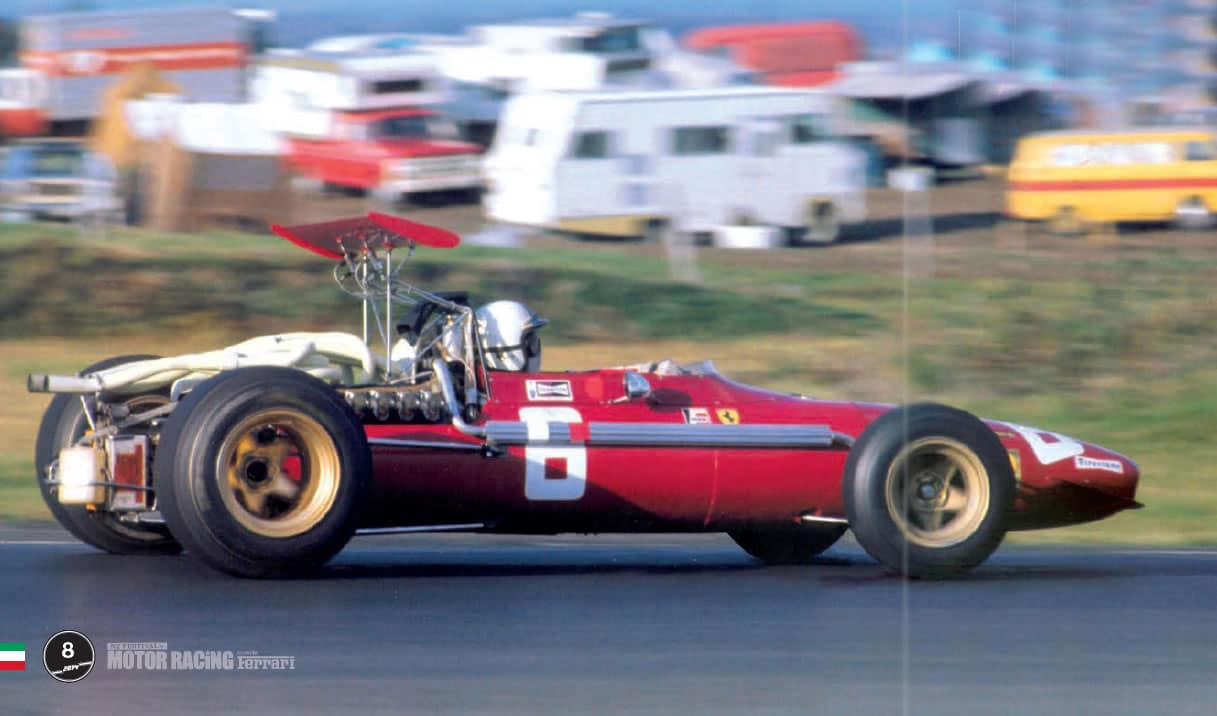
Chris Amon
Ferrari ‘Works’ Driver 1967-1969
by Michael Clark
Istarted so well — Chris Amon’s Ferrari debut came at the Daytona 24-hour race in February 1967. He was paired with Lorenzo Bandini in one of Ferrari’s achingly gorgeous P4s. In another were the other two 1966 Ferrari works drivers, Ludovico Scarfiotti and Mike Parkes. Chris was the new boy and well aware of who he was in direct competition with for the only two Formula 1 seats — it was critical to prove his speed immediately. The works Ferraris finished 1-2, the Bandini/Amon car winning by three laps. In the space of eight months, the boy from Bulls in New Zealand had won both 24-hour ‘round the clock’ sports car races — Le Mans for Ford with Bruce McLaren, and now Daytona.
In April 1967 he was again partnered with Bandini for the Monza 1000 km, and again they won. They planned to make it three from three at Le Mans but, sadly, it never happened. However, Chris did secure one of the two Grand Prix team drives and in fact drove with Bandini from the Ferrari ‘works’ in Maranello, Italy, to Monaco. Just think about that for a moment — you’re not yet 24 and you’re off to make your GP debut for the world’s most famous team at the world’s most glamorous track. It should have been a day to look back on with relish. Chris finished third and his compatriot Denny Hulme scored his debut victory. But there was no joy — Bandini had crashed late in the race,
the car was engulfed in flames and although he didn’t succumb immediately, the Italian ace stood no chance.
After an injury to Parkes, and Scarfiotti’s drop in form, Chris went from hoping to make to F1 team to being number one. He finished 1967 fourth equal in the driver’s championship, having finished races in the top three on four occasions, including leading his first Grand Prix, albeit briefly, at Watkins Glen. Things boded well for 1968 — he won the New Zealand Grand Prix and finished runner-up to Jim Clark in the Tasman Championship. The 1968 Formula 1 campaign had highs and lows. If points were awarded based on qualifying positions, Chris would have won the world championship with a race to spare. Contrary to popular opinion, the mellifluous-sounding V12s were not the most powerful engines out there — in fact, they lagged behind the Cosworths in the horsepower stakes. And as for their reliability … a pair of seconds was all Chris had to show for the four poles and all the laps he led that year.
Still, he was still only 25 and 1969 couldn’t be worse, could it? He added a second NZGP in January, and the Australian GP in February and, this time, the Tasman Championship was his. He dominated the Spanish Grand Prix until the V12 engine failed … again. The Ferrari Can-Am car was much the same story — fabulous chassis, wonderful noise, but not enough power. Ferrari were spread very thinly in ’69 — the Tasman car, F1, F2, Can-Am and Group 6, but the flat-12 F1 engine for 1970 was promising. However, after the engine failed again during testing, Chris decided enough was enough. Enzo Ferrari, famous for his unemotional stance on ‘his’ drivers, had genuine affection for the Kiwi and tried to change his mind …
On the surface, the stats don’t look half bad — Chris started 27 F1 GPs for Ferrari and was in the top three seven times. There were plenty of front row starts and laps led, but the bottom line was that things didn’t look to be improving at Ferrari. But they did and, sadly, one of Enzo’s few favourites in Chris Amon wasn’t part of it.
Source: NZFMR magazine, 2014, page 8 & 9.


No Comments